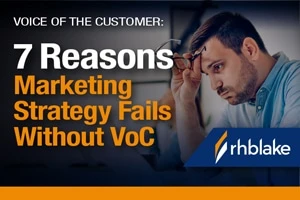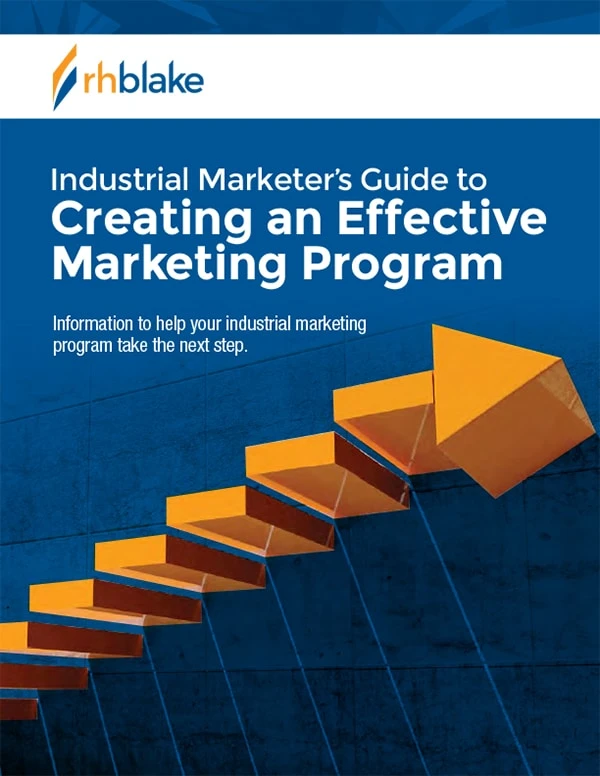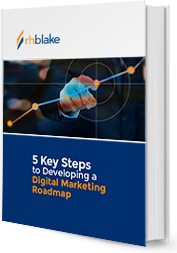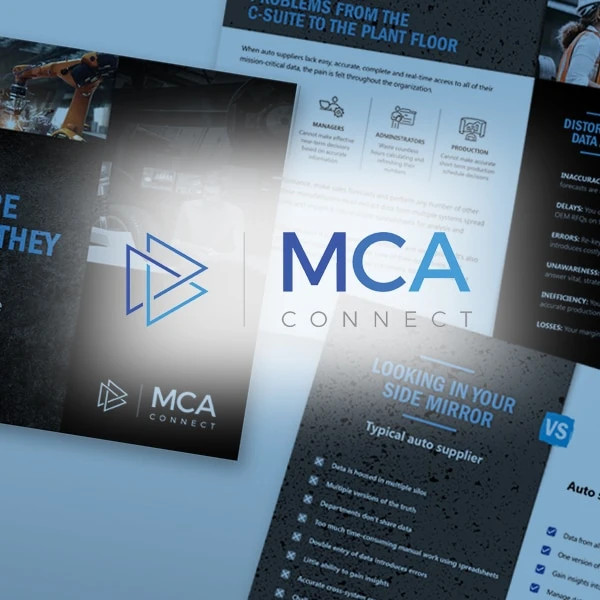Is there a gap between what you deliver and what your customers want? Is there a gulf between what you believe about your brand and what your potential buyers believe? Is there a chasm between your marketing assumptions and marketplace reality?
Voice of the Customer: 7 Reasons Marketing Strategy Fails Without VoC
Is there a gap between what you deliver and what your customers want? Is there a gulf between what you believe about your brand and what your potential buyers believe? Is there a chasm between your marketing assumptions and marketplace reality?

In short, are your marketing campaigns failing because of a lack of alignment between what you are offering and what customers are buying? At RH Blake, we continue to see industrial firms and manufacturers fail to achieve marketing objectives because of this gap.
The cure? Voice of the Customer research.
Voice of the Customer (VoC) research discovers what your customers think about your brand, your products, your services, and the entire customer experience. It uncovers what customers think about issues, where they go to make decisions, and who influences those decisions. It reveals customer attitudes, priorities and preferences. And it reveals their level of understanding of competitive offerings, alternative solutions, and plenty more.
You conduct VoC research through workshops, one-on-one interviews, online surveys, and focus groups. This research helps you understand your target market on a deeper level. You discover their pains, expectations, frustrations, questions, perceptions, complaints and other vital strategic intelligence. Without VoC research, your marketing strategy is likely to miss the mark—and fail. Here’s why.
Why Seemingly Sound Marketing Strategies Fail
1. Not Aligning with the Target Audience
Deeply understanding your target audience is the foundation of an effective marketing program. If there’s a disconnect between your marketing strategy and your market, there’s a high likelihood you’re not going to achieve your objectives
To ensure alignment, you must first understand who your target audience is, what they want, what they need, what drives them, what risks they face, and more. Only then can you create a marketing strategy that is truly aligned with your target buyers.
2. Focusing on the Wrong Pain
One of the first steps in any effective marketing strategy is understanding what your target market is struggling with—their pains, their needs, and their wants. If your buyer is concerned primarily about affordability, but you primarily focus your marketing messages on sustainability, you miss. If your market is concerned mainly about reducing waste, but you focus on improving OEE, you miss again.
Once you know what your buyers are struggling with, create a marketing campaign that addresses those specific pain points. Focus your messaging on how you help them solve their top pains.
3. Inherent Bias
Inherent bias happens when a marketer has a personal stake in the success or failure of a marketing strategy. This leads to confirmation bias, where the marketer only looks for evidence that confirms their preconceived notions about the strategy.
The result? The marketer overlooks potential problems with the strategy, or is blinded to its weaknesses. In the worst case, the bias leads to cherry-picking data that supports the strategy while ignoring data that contradicts it.
4. Lacking a Compelling “Why”
A good strategy has a clear purpose that speaks to the customer’s needs and drives the company’s business objectives. This isn’t always easy to achieve, but it’s essential if you want your marketing efforts to be successful.
Data alone isn’t enough. VoC research helps you uncover the stories and reasoning behind the numbers. This way, you develop a deeper understanding of your customers. And you develop a strategy that’s based on your customer’s real needs, not just what you think they need.
5. Targeting the Wrong Influencers
Several factors influence a single buyer’s decision. In B2B markets, a company’s buying team typically includes people from multiple departments with different priorities. An effective marketing strategy must target the right influencers within each organization to create advocates for your B2B product or service.
6. Misunderstanding the Buyer Journey
Too often manufacturers make decisions about their marketing approach based on assumptions instead of understanding what their customers are actually doing. This is a fatal mistake, as you’re essentially making decisions in the dark.
The buyer journey is the process that your customers go through when making a purchase, and you must understand this journey in order to create an effective marketing strategy. If you don’t understand which stage of the buyer journey your customers are in, you won’t create an effective marketing strategy. For example, if you’re trying to sell a product to someone who is only in the awareness stage, they’re not going to be ready to purchase anything. You need to first create content that helps them become aware of their problem or need, and then you start educating them on potential solutions.
7. Misunderstanding Perceptions of You and Your Competitors
A major reason marketing strategies fail is that the company does not have a clear understanding of how it is perceived in the marketplace, and how its competitors are perceived. This leads to ineffective messaging.
For example, you think your messages are direct. Your customers think they are blunt. You call your new tone edgy. Your buyers call it off-brand. You think your buyers perceive your closest competitor as cheaper. But they actually perceive your brand as poorly valued. Big difference.
In order to create an effective marketing strategy, you must have a deep understanding of how your company is perceived, as well as how your competitors are perceived. This helps you create messaging that resonates with your target audience.
Conclusion
Voice of the Customer research helps you understand your customers’ needs and wants. It also allows you to put yourself in your customer’s shoes, so you see things from their perspective. This type of research is a key ingredient for any marketing strategy, yet too often organizations don’t prioritize it.
RH Blake uses VoC research to help manufacturing and industrial organizations make better decisions about their marketing strategies. Contact us today to learn more about how we may be able to help you.
Is there a gap between what you deliver and what your customers want? Is there a gulf between what you believe about your brand and what your potential buyers believe? Is there a chasm between your marketing assumptions and marketplace reality?
Voice of the Customer: 7 Reasons Marketing Strategy Fails Without VoC
Is there a gap between what you deliver and what your customers want? Is there a gulf between what you believe about your brand and what your potential buyers believe? Is there a chasm between your marketing assumptions and marketplace reality?

In short, are your marketing campaigns failing because of a lack of alignment between what you are offering and what customers are buying? At RH Blake, we continue to see industrial firms and manufacturers fail to achieve marketing objectives because of this gap.
The cure? Voice of the Customer research.
Voice of the Customer (VoC) research discovers what your customers think about your brand, your products, your services, and the entire customer experience. It uncovers what customers think about issues, where they go to make decisions, and who influences those decisions. It reveals customer attitudes, priorities and preferences. And it reveals their level of understanding of competitive offerings, alternative solutions, and plenty more.
You conduct VoC research through workshops, one-on-one interviews, online surveys, and focus groups. This research helps you understand your target market on a deeper level. You discover their pains, expectations, frustrations, questions, perceptions, complaints and other vital strategic intelligence. Without VoC research, your marketing strategy is likely to miss the mark—and fail. Here’s why.
Why Seemingly Sound Marketing Strategies Fail
1. Not Aligning with the Target Audience
Deeply understanding your target audience is the foundation of an effective marketing program. If there’s a disconnect between your marketing strategy and your market, there’s a high likelihood you’re not going to achieve your objectives
To ensure alignment, you must first understand who your target audience is, what they want, what they need, what drives them, what risks they face, and more. Only then can you create a marketing strategy that is truly aligned with your target buyers.
2. Focusing on the Wrong Pain
One of the first steps in any effective marketing strategy is understanding what your target market is struggling with—their pains, their needs, and their wants. If your buyer is concerned primarily about affordability, but you primarily focus your marketing messages on sustainability, you miss. If your market is concerned mainly about reducing waste, but you focus on improving OEE, you miss again.
Once you know what your buyers are struggling with, create a marketing campaign that addresses those specific pain points. Focus your messaging on how you help them solve their top pains.
3. Inherent Bias
Inherent bias happens when a marketer has a personal stake in the success or failure of a marketing strategy. This leads to confirmation bias, where the marketer only looks for evidence that confirms their preconceived notions about the strategy.
The result? The marketer overlooks potential problems with the strategy, or is blinded to its weaknesses. In the worst case, the bias leads to cherry-picking data that supports the strategy while ignoring data that contradicts it.
4. Lacking a Compelling “Why”
A good strategy has a clear purpose that speaks to the customer’s needs and drives the company’s business objectives. This isn’t always easy to achieve, but it’s essential if you want your marketing efforts to be successful.
Data alone isn’t enough. VoC research helps you uncover the stories and reasoning behind the numbers. This way, you develop a deeper understanding of your customers. And you develop a strategy that’s based on your customer’s real needs, not just what you think they need.
5. Targeting the Wrong Influencers
Several factors influence a single buyer’s decision. In B2B markets, a company’s buying team typically includes people from multiple departments with different priorities. An effective marketing strategy must target the right influencers within each organization to create advocates for your B2B product or service.
6. Misunderstanding the Buyer Journey
Too often manufacturers make decisions about their marketing approach based on assumptions instead of understanding what their customers are actually doing. This is a fatal mistake, as you’re essentially making decisions in the dark.
The buyer journey is the process that your customers go through when making a purchase, and you must understand this journey in order to create an effective marketing strategy. If you don’t understand which stage of the buyer journey your customers are in, you won’t create an effective marketing strategy. For example, if you’re trying to sell a product to someone who is only in the awareness stage, they’re not going to be ready to purchase anything. You need to first create content that helps them become aware of their problem or need, and then you start educating them on potential solutions.
7. Misunderstanding Perceptions of You and Your Competitors
A major reason marketing strategies fail is that the company does not have a clear understanding of how it is perceived in the marketplace, and how its competitors are perceived. This leads to ineffective messaging.
For example, you think your messages are direct. Your customers think they are blunt. You call your new tone edgy. Your buyers call it off-brand. You think your buyers perceive your closest competitor as cheaper. But they actually perceive your brand as poorly valued. Big difference.
In order to create an effective marketing strategy, you must have a deep understanding of how your company is perceived, as well as how your competitors are perceived. This helps you create messaging that resonates with your target audience.
Conclusion
Voice of the Customer research helps you understand your customers’ needs and wants. It also allows you to put yourself in your customer’s shoes, so you see things from their perspective. This type of research is a key ingredient for any marketing strategy, yet too often organizations don’t prioritize it.
RH Blake uses VoC research to help manufacturing and industrial organizations make better decisions about their marketing strategies. Contact us today to learn more about how we may be able to help you.

Industrial Marketer’s Guide to Creating an Effective Marketing Program
147 pages of actionable ideas to help you create a winning marketing strategy and program

Industrial Marketer’s Guide to Creating an Effective Marketing Program
147 pages of actionable ideas to help you create a winning marketing strategy and program
Related Clients











